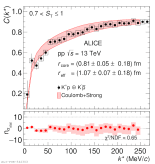Figures from paper submitted to European Physical Journal C - Particles and Fields
Abstract:
The interaction of $\rm{K}^{-}$ with protons is characterised by the presence of several coupled channels, systems like ${\rm \overline{K}^0}$n and $\pi\Sigma$ with a similar mass and the same quantum numbers as the $\rm{K}^{-}$p state. The strengths of these couplings to the $\rm{K}^{-}$p system are of crucial importance for the understanding of the nature of the $\Lambda(1405)$ resonance and of the attractive $\rm{K}^{-}$p strong interaction. In this article, we present measurements of the $\rm{K}^{-}$p correlation functions in relative momentum space obtained in pp collisions at $\sqrt{s}~=~13$ TeV, in p-Pb collisions at $\sqrt{s_{\mathrm{NN}}}~=~5.02$ TeV, and (semi)peripheral Pb-Pb collisions at $\sqrt{s_{\mathrm{NN}}}~=~5.02$ TeV. The emitting source size, composed of a core radius anchored to the $\rm{K}^{+}$p correlation and of a resonance halo specific to each particle pair, varies between 1 and 2 fm in these collision systems. The strength and the effects of the ${\rm \overline{K}^0}$n and $\pi\Sigma$ inelastic channels on the measured $\rm{K}^{-}$p correlation function are investigated in the different colliding systems by comparing the data with state-of-the-art models of chiral potentials. A novel approach to determine the conversion weights $\omega$, necessary to quantify the amount of produced inelastic channels in the correlation function, is presented. In this method, particle yields are estimated from thermal model predictions, and their kinematic distribution from blast-wave fits to measured data. The comparison of chiral potentials to the measured $\rm{K}^{-}$p interaction indicates that, while the $\pi\Sigma-\rm{K}^{-}$p dynamics is well reproduced by the model, the coupling to the ${\rm \overline{K}^0}$n channel in the model is currently underestimated.
Eur. Phys. J. C 83 (2023) 340
e-Print: arXiv:2205.15176 | PDF | inSPIRE







